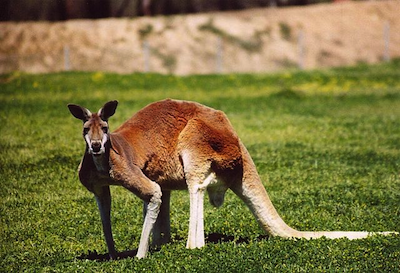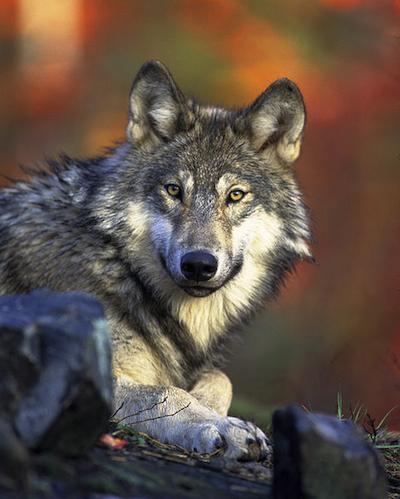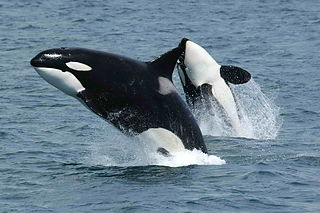Cute and Furry
Mammals evolved from reptile ancestors, just like birds. Mammals, however, came first and they came from a different reptilian stock: therapsids, descendants of the synapsids. Small mammal ancestors bided their time during the time of the dinosaurs. Once some of the major competition was gone, mammals diversified and spread.

Bat. Image from here.
The name of the class Mammalia comes from one of the major features of mammals, mammary glands. ("Mamma" in Latin means breast.) You may have noticed these before. Only mammals feed their young from a rich, nutritious fluid they create.

Hound. Image from here.
What else makes a mammal?
Bonobo. Image from here.
We forgot one, right? Mammals don't lay eggs. Actually there is an exception, though the vast majority doesn't lay eggs. There are three subclasses of mammals:
See an echidna here.
The folks down under have a very unique group of animals. The next group, marsupials, is mostly found in Australia. This includes the famous kangaroos and koalas. There is also one marsupial, the opossum, in North America and a few others in South America. Marsupials give birth to a very tiny, undeveloped baby after only a few weeks on the inside. The fetus then squirms up the mom's belly and into a pouch. Inside the pouch are the teats for nursing and a snug place to hang out for a while and grow.

Kangaroo. Image from here.
Now, drum roll please . . . us. Or, at least, this is our subclass, Eutheria. Marsupials do produce a simpler and short-lived placenta, but eutherians (sometimes called placentals) have a more complex and developed placenta and keep the entire development of a fetus in the uterus. This developmental period is called gestation and—ask your mother—it takes some time and lots of resources.

Wolf. Image from here.

Orca. Image from here.
Eutherians include over 4,000 species and are some of the most familiar to us humans – dogs, elephants, rabbits, bats, squirrels, whales and so on. Mammals live on land and in water and a few even fly. It also includes the primates and we'll get to those next.

Bat. Image from here.
The name of the class Mammalia comes from one of the major features of mammals, mammary glands. ("Mamma" in Latin means breast.) You may have noticed these before. Only mammals feed their young from a rich, nutritious fluid they create.

Hound. Image from here.
What else makes a mammal?
- Hair or fur: Even seemingly hairless mammals like dolphins have hair at some point or in some small place.
- Fancy teeth: Mammal teeth are highly specialized. Teeth within one mouth have different shapes and sizes for different purposes. Teeth also vary between different species, depending on their diet. Think about the difference between your teeth and your cat's.
- Diaphragm: This is a special muscle that helps expand the lungs.
- Big head: Mammals have relatively large brains and have a big case to protect it. Only mammals have a neocortex, a part of the brain that controls higher functions, including, in humans, language and conscious thought.
- Other unique head features: Only mammals have a single bone that makes up their lower jaw. Only mammals have three inner ear bones. Some mammals have horns or antlers and these occur only in mammals.

Bonobo. Image from here.
We forgot one, right? Mammals don't lay eggs. Actually there is an exception, though the vast majority doesn't lay eggs. There are three subclasses of mammals:
- Monotremes
- Marsupials
- Eutherians (also called placentals)
See an echidna here.
The folks down under have a very unique group of animals. The next group, marsupials, is mostly found in Australia. This includes the famous kangaroos and koalas. There is also one marsupial, the opossum, in North America and a few others in South America. Marsupials give birth to a very tiny, undeveloped baby after only a few weeks on the inside. The fetus then squirms up the mom's belly and into a pouch. Inside the pouch are the teats for nursing and a snug place to hang out for a while and grow.

Kangaroo. Image from here.
Now, drum roll please . . . us. Or, at least, this is our subclass, Eutheria. Marsupials do produce a simpler and short-lived placenta, but eutherians (sometimes called placentals) have a more complex and developed placenta and keep the entire development of a fetus in the uterus. This developmental period is called gestation and—ask your mother—it takes some time and lots of resources.

Wolf. Image from here.

Orca. Image from here.
Eutherians include over 4,000 species and are some of the most familiar to us humans – dogs, elephants, rabbits, bats, squirrels, whales and so on. Mammals live on land and in water and a few even fly. It also includes the primates and we'll get to those next.